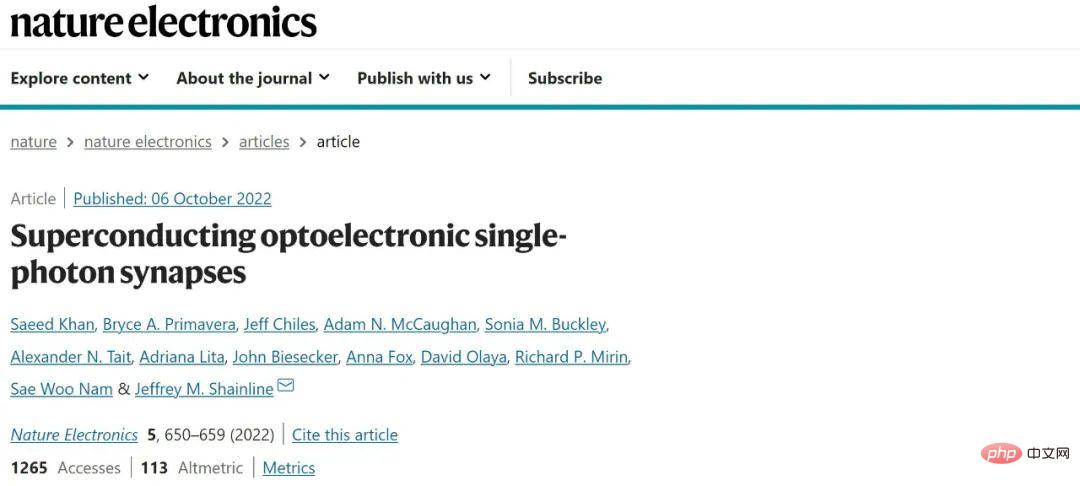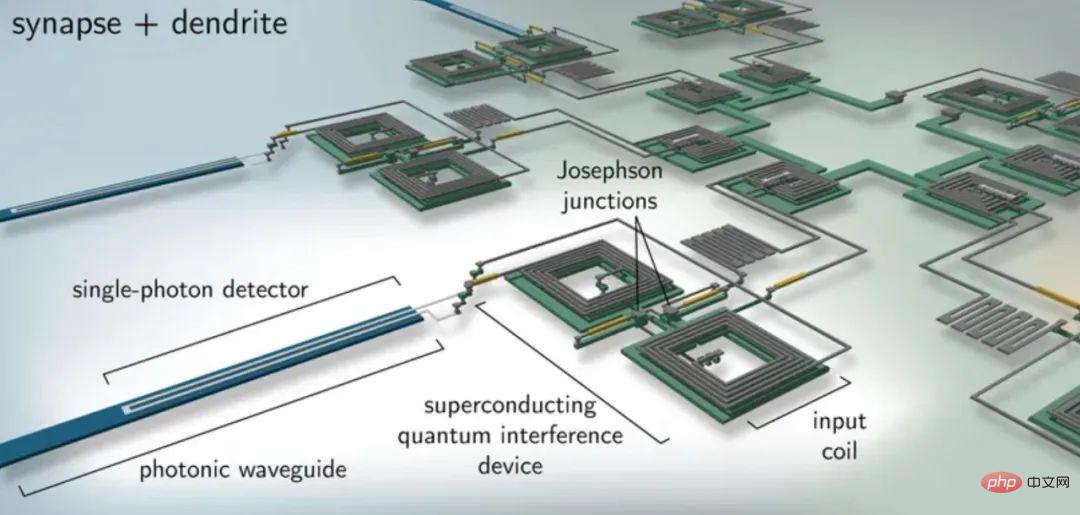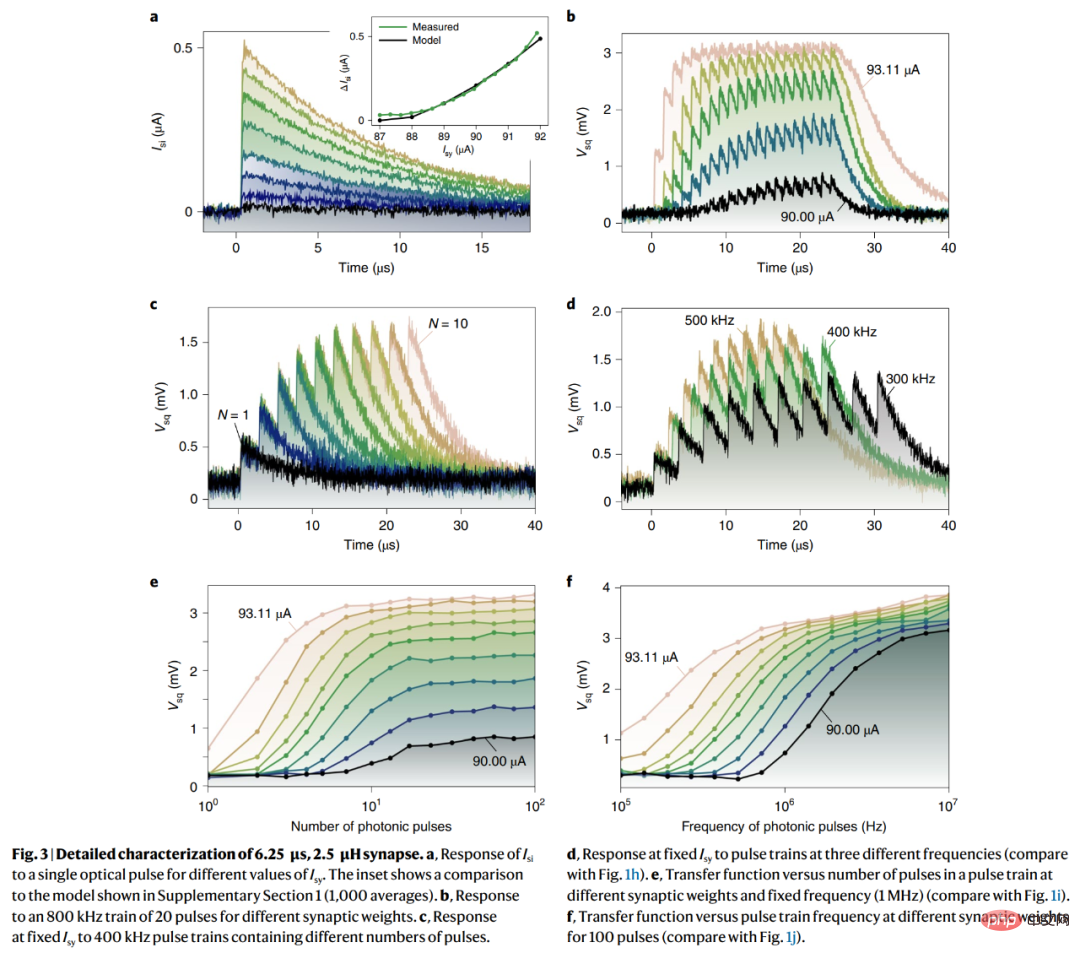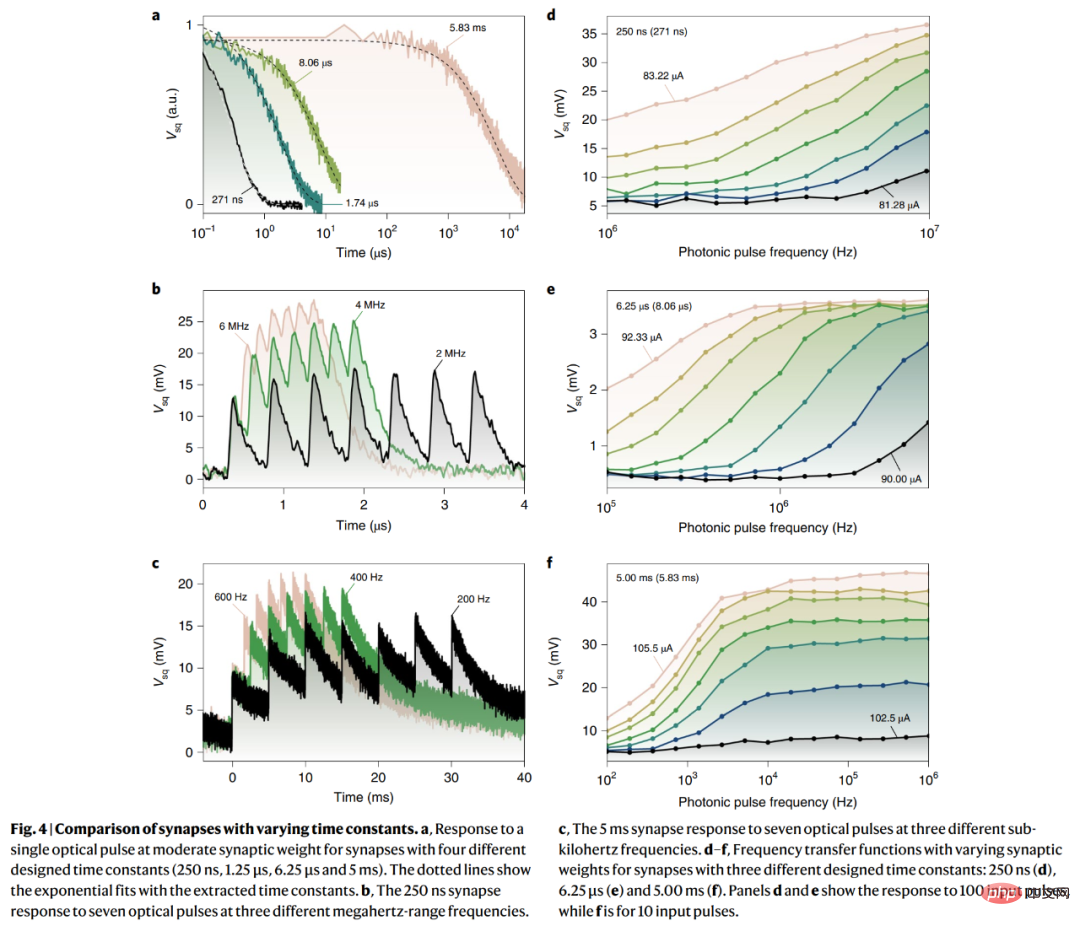 Technology peripherals
Technology peripherals
 AI
AI
 Will ultra-efficient artificial photoelectric neurons become a reality? 30,000 times faster than natural neurons, research published in Nature sub-journal
Will ultra-efficient artificial photoelectric neurons become a reality? 30,000 times faster than natural neurons, research published in Nature sub-journal
Will ultra-efficient artificial photoelectric neurons become a reality? 30,000 times faster than natural neurons, research published in Nature sub-journal
In artificial neural networks, many components called neurons are embedded in data and work together to solve problems such as face recognition. Neural networks repeatedly adjust their synapses - connections between neurons - to determine whether the resulting behavioral pattern is a better solution. But over time, the neural network will eventually find the optimal behavior pattern in the results of the calculation. It then selects these modes as default values, mimicking the human brain's learning process.
While AI systems are increasingly finding more real-world applications, they still face significant challenges given the limitations of the hardware used to drive them. To solve this problem, researchers have developed neuromorphic computer hardware inspired by the human brain.
For example, a neuromorphic microchip component might emit a spike or generate an output signal only when it receives a specific number of input signals within a certain period of time. This is a strategy that more closely simulates the way real biological neurons behave. Compared with typical artificial neural networks, these devices will only emit very few spikes, so much less data will be processed, while in principle requiring much less power and communication bandwidth.
However, neuromorphic hardware often uses traditional electronics, which ultimately limits the complex functionality and signaling speed they can achieve. For example, each biological neuron can have tens of thousands of synapses, but neuromorphic devices have difficulty connecting their artificial neurons to each other. An effective solution to this problem is multiplexing, that is, one signal channel can carry more signals at the same time. However, as chips become larger and more sophisticated, computing speeds can slow down.
In a recent new study, researchers at the National Institute of Standards and Technology (NIST) explored the use of optical transmitters and receivers to connect Neurons. In principle, optical links, or optical waveguides, could connect each neuron to thousands of other neurons at light speed communication rates. Relevant papers were published in Nature Electronics.

Research Overview
Researchers
used a superconducting nanowire device capable of detecting single photons, which can detect These optical signals are the smallest units and can be viewed as the physical limit of energy efficiency. The rendering below shows how superconducting circuits that simulate neuronal synapses (the interface points between neurons in the brain) could be used to create the artificial optoelectronic neurons of the future.
 Performing photonic neural computations is often tricky because they typically require optical cavities that can capture light for significant periods of time. Creating such cavities on integrated microchips and connecting them with many waveguides is extremely challenging.
Performing photonic neural computations is often tricky because they typically require optical cavities that can capture light for significant periods of time. Creating such cavities on integrated microchips and connecting them with many waveguides is extremely challenging.
So the researchers developed a hybrid circuit system in which the output signal from each detector is converted into ultrafast electrical pulses about 2 picoseconds long.
These pulses are caused by a single magnetic fluctuation or magnetic flux within a network of superconducting quantum interferometers, or a superconducting quantum interferometer (SQUID). Jeffrey Shainline, a researcher at NIST and corresponding author, said, "For many years, we have been working hard on theoretical research to discover the nature of the physical limits that will enable technology to achieve neuromorphic computing. Principle. The pursuit of this goal led us to this concept - combining optical communication at single photon energy levels with neural network calculations performed by Josephson junctions."
超The conductive quantum interferometer (SQUID) is composed of one or more Josephson structures. It is a sandwich structure with superconducting materials on the top and bottom, separated by an insulating film in the middle. If the current through the Josephson junction (JJ) exceeds a certain threshold, the superconducting quantum interferometer will start to produce magnetic flux.
After sensing a photon, a single-photon detector (SPD) generates magnetic flux quanta, which are then collected as electric current in the SQUID's superconducting loop. This stored current serves as a form of memory, recording how many times the neuron spiked.
Figure 2 below shows the layout and completed circuit. a is the 3D layout of the entire synaptic circuit; b is the microscope image of the completed manufacturing; c is the SPD layout; d is the SPD in manufacturing; e is the layout of JJ and shunt resistor; f is the JJ and shunt in manufacturing; g is the SQUID used for DR (dendritic receiving, dendritic receiving) cycle; h is the DR SQUID in manufacturing.

Shainline exclaimed, “It was actually quite easy to make the circuit work. It took quite a bit of time during the design phase to fabricate and experiment, but in reality On the other hand, when we first fabricated these circuits, they were already working. This bodes well for the future scalability of such systems."
Researcher Integrating the single-photon detector with the Josephson junction creates a superconducting synapse. They calculated that the peak frequency of synapses can exceed 10 million Hz, while each synaptic event consumes approximately 33 attojoules of energy (1 attojoule is equal to 10^-18 joules). By comparison, the maximum average spike rate of human neurons is only about 340 Hz, while each synaptic event consumes about 10 femtojoules (1 femtojoule is equal to 10^-15 joules).
Figure 3 below shows the characteristics of a single synapse with a time constant of 6.25 μs and an inductance of 2.5 μH. Measurements show actual values of 8.06 μs and 3.2 μH respectively.

Figure 4 below demonstrates that synaptic transfer functions can be engineered over a wide range of time scales.

In addition, researchers can realize the output time of these circuit system devices changing from hundreds of nanoseconds to milliseconds. This also means that these hardware can be connected to a range of systems, from communication between high-speed electronic devices to more leisurely interactions between humans and machines.
In the future, the researchers will combine the new synapses they developed with on-chip light sources to create fully integrated superconducting neurons. Shainline said, "There are still huge challenges in achieving fully integrated superconducting neurons, but if we can integrate that last part, then there is every reason to believe that it may eventually become a powerful computing platform for artificial intelligence."
The above is the detailed content of Will ultra-efficient artificial photoelectric neurons become a reality? 30,000 times faster than natural neurons, research published in Nature sub-journal. For more information, please follow other related articles on the PHP Chinese website!

Hot AI Tools

Undresser.AI Undress
AI-powered app for creating realistic nude photos

AI Clothes Remover
Online AI tool for removing clothes from photos.

Undress AI Tool
Undress images for free

Clothoff.io
AI clothes remover

Video Face Swap
Swap faces in any video effortlessly with our completely free AI face swap tool!

Hot Article

Hot Tools

Notepad++7.3.1
Easy-to-use and free code editor

SublimeText3 Chinese version
Chinese version, very easy to use

Zend Studio 13.0.1
Powerful PHP integrated development environment

Dreamweaver CS6
Visual web development tools

SublimeText3 Mac version
God-level code editing software (SublimeText3)

Hot Topics
 How to use the chrono library in C?
Apr 28, 2025 pm 10:18 PM
How to use the chrono library in C?
Apr 28, 2025 pm 10:18 PM
Using the chrono library in C can allow you to control time and time intervals more accurately. Let's explore the charm of this library. C's chrono library is part of the standard library, which provides a modern way to deal with time and time intervals. For programmers who have suffered from time.h and ctime, chrono is undoubtedly a boon. It not only improves the readability and maintainability of the code, but also provides higher accuracy and flexibility. Let's start with the basics. The chrono library mainly includes the following key components: std::chrono::system_clock: represents the system clock, used to obtain the current time. std::chron
 Which of the top ten currency trading platforms in the world are the latest version of the top ten currency trading platforms
Apr 28, 2025 pm 08:09 PM
Which of the top ten currency trading platforms in the world are the latest version of the top ten currency trading platforms
Apr 28, 2025 pm 08:09 PM
The top ten cryptocurrency trading platforms in the world include Binance, OKX, Gate.io, Coinbase, Kraken, Huobi Global, Bitfinex, Bittrex, KuCoin and Poloniex, all of which provide a variety of trading methods and powerful security measures.
 Decryption Gate.io Strategy Upgrade: How to Redefine Crypto Asset Management in MeMebox 2.0?
Apr 28, 2025 pm 03:33 PM
Decryption Gate.io Strategy Upgrade: How to Redefine Crypto Asset Management in MeMebox 2.0?
Apr 28, 2025 pm 03:33 PM
MeMebox 2.0 redefines crypto asset management through innovative architecture and performance breakthroughs. 1) It solves three major pain points: asset silos, income decay and paradox of security and convenience. 2) Through intelligent asset hubs, dynamic risk management and return enhancement engines, cross-chain transfer speed, average yield rate and security incident response speed are improved. 3) Provide users with asset visualization, policy automation and governance integration, realizing user value reconstruction. 4) Through ecological collaboration and compliance innovation, the overall effectiveness of the platform has been enhanced. 5) In the future, smart contract insurance pools, forecast market integration and AI-driven asset allocation will be launched to continue to lead the development of the industry.
 How much is Bitcoin worth
Apr 28, 2025 pm 07:42 PM
How much is Bitcoin worth
Apr 28, 2025 pm 07:42 PM
Bitcoin’s price ranges from $20,000 to $30,000. 1. Bitcoin’s price has fluctuated dramatically since 2009, reaching nearly $20,000 in 2017 and nearly $60,000 in 2021. 2. Prices are affected by factors such as market demand, supply, and macroeconomic environment. 3. Get real-time prices through exchanges, mobile apps and websites. 4. Bitcoin price is highly volatile, driven by market sentiment and external factors. 5. It has a certain relationship with traditional financial markets and is affected by global stock markets, the strength of the US dollar, etc. 6. The long-term trend is bullish, but risks need to be assessed with caution.
 Recommended reliable digital currency trading platforms. Top 10 digital currency exchanges in the world. 2025
Apr 28, 2025 pm 04:30 PM
Recommended reliable digital currency trading platforms. Top 10 digital currency exchanges in the world. 2025
Apr 28, 2025 pm 04:30 PM
Recommended reliable digital currency trading platforms: 1. OKX, 2. Binance, 3. Coinbase, 4. Kraken, 5. Huobi, 6. KuCoin, 7. Bitfinex, 8. Gemini, 9. Bitstamp, 10. Poloniex, these platforms are known for their security, user experience and diverse functions, suitable for users at different levels of digital currency transactions
 Bitcoin price today
Apr 28, 2025 pm 07:39 PM
Bitcoin price today
Apr 28, 2025 pm 07:39 PM
Bitcoin’s price fluctuations today are affected by many factors such as macroeconomics, policies, and market sentiment. Investors need to pay attention to technical and fundamental analysis to make informed decisions.
 What are the top ten virtual currency trading apps? The latest digital currency exchange rankings
Apr 28, 2025 pm 08:03 PM
What are the top ten virtual currency trading apps? The latest digital currency exchange rankings
Apr 28, 2025 pm 08:03 PM
The top ten digital currency exchanges such as Binance, OKX, gate.io have improved their systems, efficient diversified transactions and strict security measures.
 Which of the top ten currency trading platforms in the world are among the top ten currency trading platforms in 2025
Apr 28, 2025 pm 08:12 PM
Which of the top ten currency trading platforms in the world are among the top ten currency trading platforms in 2025
Apr 28, 2025 pm 08:12 PM
The top ten cryptocurrency exchanges in the world in 2025 include Binance, OKX, Gate.io, Coinbase, Kraken, Huobi, Bitfinex, KuCoin, Bittrex and Poloniex, all of which are known for their high trading volume and security.





